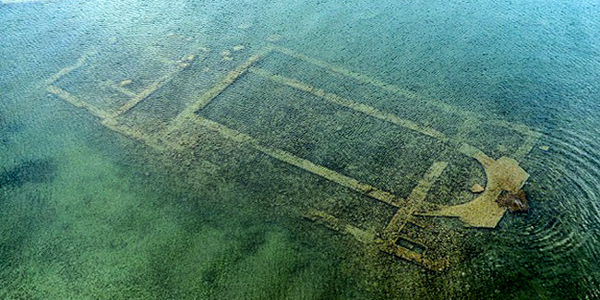“God from God, Light from Light, true God from true God, begotten, not made, consubstantial with the Father; through him all things were made.”
The familiar words of the Nicene Creed, recited at Catholic Masses after the homily as a “Profession of Faith,” date back to the First Council of Nicaea held in 325. They were formulated to affirm the Church’s teaching on the divinity of Christ and combat a dangerous heresy taking root within the Church.
Today archaeologists believe they may have found the site where the Church’s leaders introduced the Creed in what is now Turkey.
The discovery in 2014 of a 1,600-year-old Byzantine basilica lying 6 to10 feet under water at the bottom of Lake Iznik, in Bursa, Turkey, provided a breakthrough in a century-long search for a church in Nicaea.
Mustafa Şahin, head of archaeology at Bursa Uludağ University, discovered the ruins after looking at aerial photographs.
“We have found church remains. It is in a basilica plan and has three naves,” Şahintold Hurriyet News at the time of the discovery.
“When I first saw the images of the lake, I was quite surprised to see a church structure that clearly,” Şahin told Live Science in an email. “I was doing field surveys in Iznik [since 2006], and I hadn’t discovered such a magnificent structure like that.”
Şahin now believes that basilica, which dates to the late 4th to early 5th century, may have been built on the very site where the Church’s bishops met to affirm the doctrine that Catholics recite in Mass every day all over the world.
The Council was called by the emperor Constantine I to put an end to discord within the Church brought about by a priest named Arius of Alexander, who preached that Jesus was a created being, and not God, as the Father is God. To combat this heresy, known as Arianism, Constantine asked bishops from all over Christendom to come to Nicaea.
As many as 300 bishops arrived in what is now northwest Turkey to take part in the proceedings, which were opened and led by Constantine himself. To accommodate so many bishops as well as a number of priests, deacons and acolytes, a large place was needed, and one that would have been accessible to those coming from Africa, Asia, Syria, Palestine, Egypt, and Greece.
On the opening day of the Council, Constantine began the proceedings dressed in jewel-encrusted gold, seated on a golden throne, with an appeal to come together.
“Division in the church is worse than war,” he appealed to the assembled bishops, who voted overwhelmingly against Arius, establishing the divinity of the Blessed Trinity as Church doctrine.
Since the underwater basilica was found, subsequent discoveries have revealed that the basilica was built over an earlier church building, which was itself built over a necropolis, according to a report in Biblical Archaeology Review.
The basilica’s nave was found to lie 1.6 feet lower than its walls, indicating that an earlier structure was under the basilica, according to archaeologists.
In an article for Biblical Archaeology Review, Şahin and Mark Fairchild suggest that the earlier structure may have been the site of the Nicaean Council.
The authors “posit that the early Christian church underneath the fourth–fifth-century basilica, constructed at such a meaningful location, could have been the place where Constantine first convened over 300 bishops in 325 A.D. The Council of Nicaea would eventually move to—and conclude in—Constantine’s palace in Nicaea.”
The site of the earlier structure, the authors write, could be tied to the martyrdom of St. Neophytos, who according to late Byzantine tradition was executed in Nicaea between 284 and 305 for refusing the Roman emperor Diocletian’s order to offer a sacrifice the gods.
“It was common for early Christians to desire burial near the tombs of saints and martyrs. These places became sites for memorials, as well as places for worship. This may account for the reason this church was built not only outside of the city walls of Nicaea, but also over a burial site.,” write Şahin and Fairchild.
To read the entire article by Şahin and Fairchild, visit the Biblical Archaeology Review website.
Plans are now underway to open an underwater museum to allow tourists to view the foundation of the church.
Archaeologists have determined that the basilica collapsed during an earthquake in 740 and was never rebuilt. The ruins were submerged over time by changes in the water level of the lake. The discovery of the basilica was named one of the Top 10 Discoveries of 2014 by the Archaeological Institute of America.

